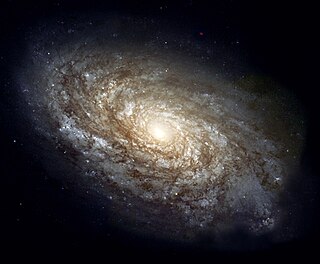
A galaxy is a system of stars, stellar remnants, interstellar gas, dust, and dark matter bound together by gravity. The word is derived from the Greek galaxias (γαλαξίας), literally 'milky', a reference to the Milky Way galaxy that contains the Solar System. Galaxies, averaging an estimated 100 million stars, range in size from dwarfs with less than a thousand stars, to the largest galaxies known – supergiants with one hundred trillion stars, each orbiting its galaxy's center of mass. Most of the mass in a typical galaxy is in the form of dark matter, with only a few percent of that mass visible in the form of stars and nebulae. Supermassive black holes are a common feature at the centres of galaxies.
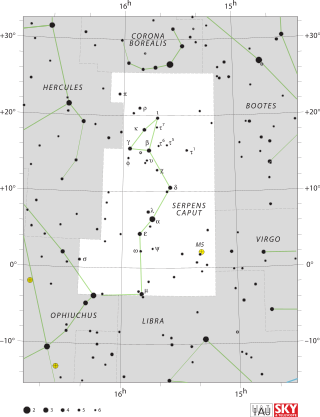
Serpens is a constellation in the northern celestial hemisphere. One of the 48 constellations listed by the 2nd-century astronomer Ptolemy, it remains one of the 88 modern constellations designated by the International Astronomical Union. It is unique among the modern constellations in being split into two non-contiguous parts, Serpens Caput to the west and Serpens Cauda to the east. Between these two halves lies the constellation of Ophiuchus, the "Serpent-Bearer". In figurative representations, the body of the serpent is represented as passing behind Ophiuchus between Mu Serpentis in Serpens Caput and Nu Serpentis in Serpens Cauda.

The Galactic Center is the barycenter of the Milky Way and a corresponding point on the rotational axis of the galaxy. Its central massive object is a supermassive black hole of about 4 million solar masses, which is called Sagittarius A*, a compact radio source which is almost exactly at the galactic rotational center. The Galactic Center is approximately 8 kiloparsecs (26,000 ly) away from Earth in the direction of the constellations Sagittarius, Ophiuchus, and Scorpius, where the Milky Way appears brightest, visually close to the Butterfly Cluster (M6) or the star Shaula, south to the Pipe Nebula.

The Pistol Star is an extremely luminous blue hypergiant star, one of the most luminous and massive known stars in the Milky Way. It is one of many massive young stars in the Quintuplet cluster in the Galactic Center region. The star owes its name to the shape of the Pistol Nebula, which it illuminates. It is located approximately 25,000 light-years from Earth in the direction of Sagittarius. The star has a large mass comparable to V4998 Sagittarii and a luminosity 3.3 million times that of the Sun (L☉). It would be visible to the naked eye as a 4th-magnitude star if it were not for the interstellar dust near the Center of the Milky Way that absorbs almost all of its visible light.

Sagittarius A*, abbreviated as Sgr A*, is the supermassive black hole at the Galactic Center of the Milky Way. Viewed from Earth, it is located near the border of the constellations Sagittarius and Scorpius, about 5.6° south of the ecliptic, visually close to the Butterfly Cluster (M6) and Lambda Scorpii.

Messier 56 is a globular cluster in the constellation Lyra. It was discovered by Charles Messier in 1779. It is angularly found about midway between Albireo and Sulafat. In a good night sky it is tricky to find with large (50–80 mm) binoculars, appearing as a slightly fuzzy star. The cluster can be resolved using a telescope with an aperture of 8 in (20 cm) or larger.
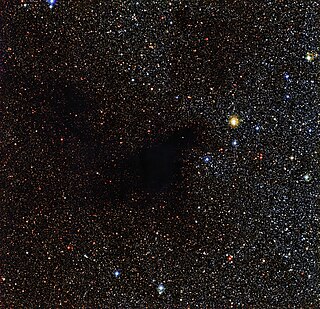
In astronomy, extinction is the absorption and scattering of electromagnetic radiation by dust and gas between an emitting astronomical object and the observer. Interstellar extinction was first documented as such in 1930 by Robert Julius Trumpler. However, its effects had been noted in 1847 by Friedrich Georg Wilhelm von Struve, and its effect on the colors of stars had been observed by a number of individuals who did not connect it with the general presence of galactic dust. For stars lying near the plane of the Milky Way which are within a few thousand parsecs of the Earth, extinction in the visual band of frequencies is roughly 1.8 magnitudes per kiloparsec.

LBV 1806−20 is a candidate luminous blue variable (LBV) and likely binary star located around 28,000 light-years (8,700 pc) from the Sun, towards the center of the Milky Way. It has an estimated mass of around 36 solar masses and an estimated variable luminosity of around two million times that of the Sun. It is highly luminous but is invisible from the Solar System at visual wavelengths because less than one billionth of its visible light reaches us.
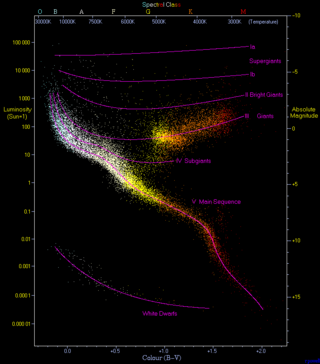
The red clump is a clustering of red giants in the Hertzsprung–Russell diagram at around 5,000 K and absolute magnitude (MV) +0.5, slightly hotter than most red-giant-branch stars of the same luminosity. It is visible as a denser region of the red-giant branch or a bulge towards hotter temperatures. It is prominent in many galactic open clusters, and it is also noticeable in many intermediate-age globular clusters and in nearby field stars.
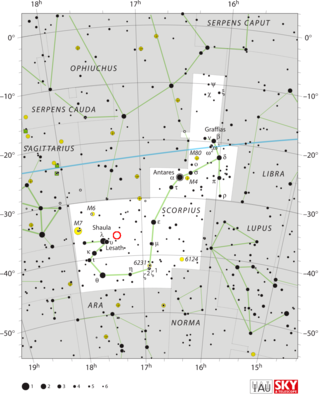
NGC 6334, colloquially known as the Cat's Paw Nebula, or Gum 64, is an emission nebula and star-forming region located in the constellation Scorpius. NGC 6334 was discovered by astronomer John Herschel in 1837, who observed it from the Cape of Good Hope in South Africa. The nebula is located in the Carina–Sagittarius Arm of the Milky Way, at a distance of approximately 5.5 kilolight-years from the Sun.

NGC 6522 is a globular cluster of stars in the southern constellation of Sagittarius. It was discovered by German-British astronomer William Herschel on June 24, 1784. The cluster has an apparent visual magnitude of 8.3 and an angular diameter of 9.4′. It is located at a distance of 25.1 kly (7.7 kpc) from the Sun, and lies in the Milky Way's central bulge, about 2.0 kly (0.6 kpc) from the Galactic Center. The cluster is centered in a region of the sky known as Baade's Window. It is highly impacted by reddening due to interstellar dust and the view is heavily contaminated by field stars, making it more difficult identify members.
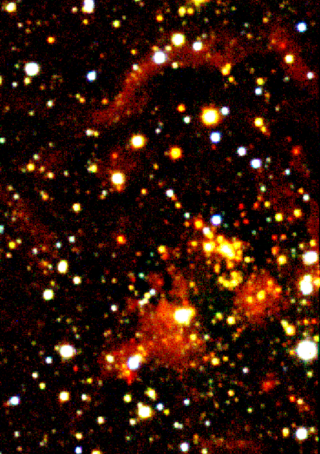
In astronomy Westerhout 49 also known as W49, is a strong galactic thermal radio source characteristic of an HII region. It was discovered by Gart Westerhout in 1958.
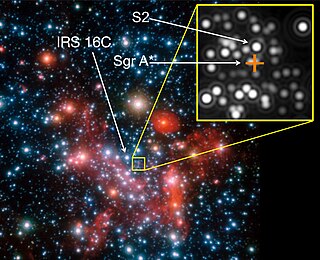
S2, also known as S0–2, is a star in the star cluster close to the supermassive black hole Sagittarius A* (Sgr A*), orbiting it with a period of 16.0518 years, a semi-major axis of about 970 au, and a pericenter distance of 17 light hours – an orbit with a period only about 30% longer than that of Jupiter around the Sun, but coming no closer than about four times the distance of Neptune from the Sun. The mass when the star first formed is estimated by the European Southern Observatory (ESO) to have been approximately 14 M☉. Based on its spectral type, it probably has a mass of 10 to 15 solar masses.

Westerhout 43, also known as W43, is a region of star formation of our galaxy located in the constellation of Aquila at a distance of 6 kilo-parsecs of the Sun, that is considered the region of the Milky Way that is most actively forming stars. Despite this, however, it is so heavily obscured by the interstellar dust that it is totally invisible in the optical and must be studied using other wavelengths that are not affected by it, such as the infrared or the radio waves.
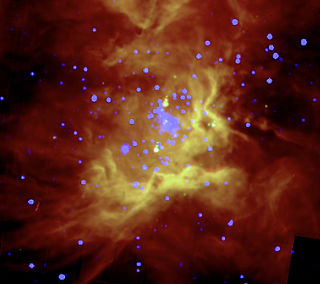
RCW 36 is an emission nebula containing an open cluster in the constellation Vela. This H II region is part of a larger-scale star-forming complex known as the Vela Molecular Ridge (VMR), a collection of molecular clouds in the Milky Way that contain multiple sites of ongoing star-formation activity. The VMR is made up of several distinct clouds, and RCW 36 is embedded in the VMR Cloud C.
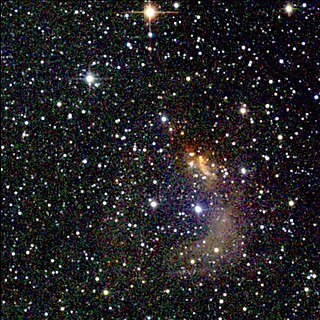
Vela Molecular Ridge is a molecular cloud complex in the constellations Vela and Puppis. Radio 12CO observations of the region showed the ridge to be composed of several clouds, each with masses 100,000–1,000,000 M☉. This cloud complex lies on the sky in the direction of the Gum Nebula (foreground) and the Carina–Sagittarius Spiral Arm (background). The most important clouds in the region are identified by the letters A, B, C and D, and in fact belong to two different complexes: the clouds A, C and D are located at an average distance of about 700-1000 parsecs and are related to the OB association Vela R2, while cloud B is located at a greater distance, up to 2000 parsecs away, and is physically connected to the extended Vela OB1 association.
Naomi McClure-Griffiths is an American-born Australian astrophysicist and radio astronomer. In 2004, she discovered a new spiral arm in the Milky Way galaxy. She was awarded the Prime Minister's Malcolm McIntosh Prize for Physical Scientist in 2006 and in 2015 was honored for her research in physics by receipt of the Pawsey Medal from the Australian Academy of Science. This was followed by an Australian Laureate Fellowship in 2021, while in 2022 she was elected a Fellow of the Australian Academy of Science.

HM 1, also known as Havlen-Moffat 1, is an open cluster located in the constellation of Scorpius, close to the galactic plane. It was first observed by R. J. Havlen and A. F. J. Moffat in 1976. HM 1 is thought to be 9,500 to 12,700 light-years away from the Earth, beyond the Carina–Sagittarius Arm. It is heavily reddened by interstellar extinction, so although it comprises mostly blue-colored stars, it appears brighter for longer-wavelength passbands. It is projected against the H II region known as RCW 121, and appears to be the source of ionization for the nearby regions RCW 122 and RCW 123.

















